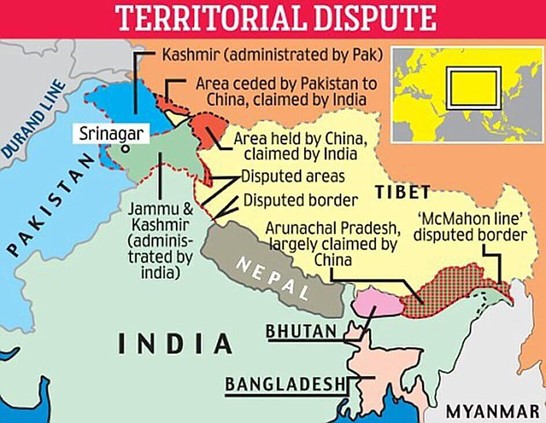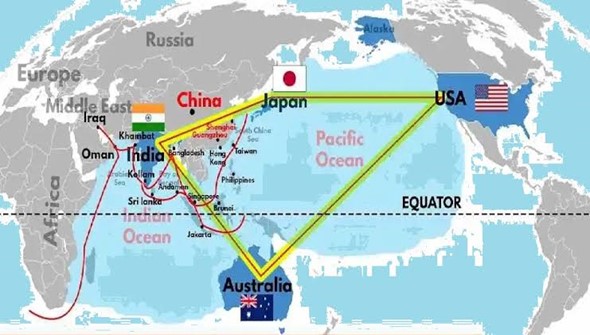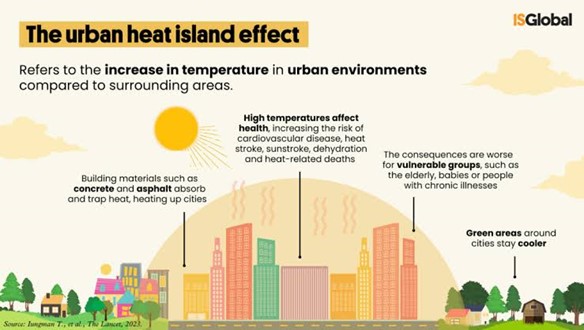Contents:
- China, India and New Delhi’s Quad Dilemma
- Take the Gauntlet
- A critical message for the urban elite
China, India and New Delhi’s Quad Dilemma
The recent meeting of Quad in September led to the Wilmington declaration. Although not said, it’s very clear that Quad is turning into a security alliance, and the major objective of Quad is to counter China’s influence, particularly in the Indo-Pacific region.
Relevance: GS2 (International relations)
Practice question: Discuss the significance of India’s involvement in the Quad and its impact on the Indo-China relationship. Suggest measures for India to maintain a balance between strategic autonomy and deepening ties with like-minded democracies. (250 words)

Quad evolution and significance for India
Four democracies, India, the US, Japan and Australia, came forward and created Quad for a free, open and inclusive Indo-Pacific Region. Initially claimed to be a non-military group, it was seen as a platform to counter China’s aggression in the region.

Wilmington declaration :
•It is the Fourth Quad Leaders summit hosted by the USA
● Quad’s Commitment:
Reaffirmed commitment to peace, stability, and prosperity in the Indo-Pacific.
● China’s aggressions:
Condemned China’s maritime aggression in the South China Sea and urged adherence to international law.
● Taiwan Support:
Reaffirmed support for Taiwan’s peace and stability.
● Multilateral Cooperation:
Pledged to promote economic, technological growth and health security
India’s strategic move :
Through Quad, India affirms its key position in the region, countering China’s assertiveness, and pursues its economic and strategic interests like trade routes and important sea lanes.
India china relation :
● Historical context :
India and China have complex, unresolved border disputes dating back to the McMohan line and the 1962 war. Recent standoffs at Galwan Valley have escalated tensions. The line of actual control remains a flashpoint
● Stalemate :
Multiple rounds of talks between countries didn’t help in disengagement across flashpoints like Galwan, Depsang Plains and Demchok. India is modernising its military while increasing its vigilance across LAC, and China is increasing its military budget.
● China’s assertiveness :
China has shifted from earlier President Deng Xiaoping’s strategy of “hide your strength, bide your time” to testing its neighbours and showing no interest in territorial issue compromises.
Challenges for India :
Balancing Quad engagement and a delicate relationship with China is a strategic challenge. India, with non-alignment and strategic autonomy doctrine, calls for careful diplomacy. It should increase its ties with the West and avoid unnecessary escalation with China.
India’s dilemmas :
India’s traditional foreign policy is rooted in non-alignment and strategic autonomy. Joining any formal defence grouping hampers India’s foreign policy independence, and at the same time, Quad provides a framework to address common security challenges without compromising its autonomy. China is very critical of Quad, calling it a mini-NATO and Asia’s NATO. China’s growing threat perception about Quad may increase hostility.
Military modernisation and assertive posture :
● India’s military preparedness :
India is deploying more forces despite winter along LAC. India is modernising its military equipment like long-range weapon systems, artillery, and rocket systems :
● China’s Assertive Military Budget:
To counter India’s geographical advantage and international collaborations, China is spending heavily on its military
● Geopolitical implications :
- Indo-Pacific regions turning platform for strategic competition for global powers.
- In response, China may promote closer ties with Pakistan
- US-China rivalry may compel southeast nations to take sides.
Key steps India needs to maintain :
- India should call for nuanced diplomacy, considering long-term perspective.
- India should focus on enhancing infrastructure along the LAC to ensure swift mobilisation of troops and resources.
- India should act as a balancing power, ensuring regional tensions shouldn’t blow out of proportion and keep rule-based order in the Indo-Pacific region.
- India should engage China in dialogues of trade, climate change and other areas where both countries have common interests.
Conclusion
Post Wilmington. Declaration there is a significant shift in geo-political dimensions in the Indo-Pacific region. India should face the challenge of maintaining Western ties along with improving relationships with China. A careful approach is needed where India maintains its strategic autonomy and interests without unnecessary escalation with China.
Take the gauntlet
The train collision in Kavaraipettai near Chennai on October 11, 2023, while fortunately not resulting in any fatalities, indicates significant issues with the Indian railway system. The incident raises questions about infrastructure, occupational safety, and railways management. It’s a wake-up call for the urgent need for reforms in the Indian railway system.
Relevance: GS2 ( governance ), GS 3 ( Disaster management, Technology )
Practice question: examine challenges faced by Indian railways in assuring passengers’ safety and the role of tech solutions like Kavach in enhancing train safety . Suggest important measures to enhance railway staff performance. 250 words
Incident, Kavach and failures :
Accident: A passenger train, the Mysore-Darbhanga Bagmati Express, collided with a stationary goods train at the Kavaraipettai railway station. The accident resulted in the derailment of 13 coaches and a fire breaking out in two of them.
● Kavach system :
Kavach is a train protection system designed to avoid collision using automatic -warning systems (AWS), collision devices (ACD) and overspeed control. However, its coverage is limited, with only 2 % of the network equipped so far.
● Over-reliance on Kavach :
While kavach is a crucial component for train safety, it’s not a panacea to avoid accidents, calls for the updation of the entire signalling system, capacity building of staff,etc.
Challenges :
● Staffing Issues:
Railway staff, especially locomotive pilots, face poor working conditions such as 12-hour shifts, unhygienic resting facilities, and lack of basic amenities like toilets on engines. These factors lead to fatigue and reduced performance, posing a significant risk to operational safety.
● Human Factor in Safety:
•Despite advanced systems like ‘Kavach,’ human intervention remains crucial. Fatigue and stress among staff, driven by inadequate working conditions, threaten the effectiveness of safety measures. Infrastructure and Funding Deficiencies:
● Ageing Infrastructure:
Much of India’s railway infrastructure, including tracks, bridges, and signalling systems, is outdated and in urgent need of modernization.
● Overburdened Network:
High-density routes frequently exceed 100% utilization, leading to increased strain and a higher risk of accidents.
● Budgetary Constraints:
Despite growing capital expenditure, the Railways face funding shortages for critical upgrades, relying heavily on government support. Revenue growth is slowing, and over-dependence on coal freight makes future investments uncertain.
• Eg:kavach system cost is ₹50 lakh per kilometre, with limited coverage of approximately 1,500 km currently, posing a challenge in comprehensive implementation across the 68,000 km rail network.
Suggested Solutions and measures.
- Accelerating Kavach Implementation: full implementation of Kavach may take many years, and accident-prone areas should be covered as a priority.
- Updating signalling system: the error-prone old signal system needs to be replaced with an error-free new signal system.
- Improving Staff Welfare: providing better amenities, mental health support, and suitable capacity-building exercises for staff to be resilient.
- Public-Private Partnerships: Engaging with the private sector through public-private partnerships (PPPs) can provide the necessary investment and expertise to modernize the Railways. This can include infrastructure development, safety upgrades, and passenger service improvements.
Conclusion :
The government’s responses to railway accidents have included counter-terrorism probes, which is a strategic step. Issues like infrastructure, staff wellness, funding, and operational procedures need to be addressed for better passenger safety, which is very crucial to avoid future train disasters.
Facts and figures :
Train Accidents
Average Incidents: 43 per year.
Fatalities: Average of 56 annually; 219 in 2023 due to a major collision.
Causes: 53% human error, 4% collisions.
Significant Railway Accidents
Odisha, 2023: A major collision involving three trains resulted in 219 fatalities.
Amritsar, 2018: A train ran over a crowd watching Dussehra celebrations, killing 59 people.
Kanpur, 2016: The Indore-Patna Express derailed, causing 150 deaths.
Gaisal, 1999: A head-on collision between two trains killed 285 people.
Railway Budget 2024-25
Kavach System: ₹1,112.57 crore allocated.
Safety and Training: ₹416.83 crore allocated.
A Critical Message For The Urban Elite
India has been facing a severe heat crisis in recent times, including Delhi surpassing 50°C.urban heat island effect is a significant contributor to rising temperatures. The marginalised and poor are facing severe impacts of heat waves compared to the elite, demanding urgent attention.
Relevance: GS1 ( Geography, Society).
Practice question: Discuss the impacts of urban heat waves in India, with a special focus on marginalised communities. Suggest some important measures to mitigate the challenges. (250 words)
● The Urban Heat Island Effect (UHI)
The UHI effect, caused by human activities and heat-retaining materials like concrete and glass, makes cities significantly warmer than rural areas. Urban design worsens this effect, especially in modern corporate hubs like Gurugram, where sleek glass buildings increase energy consumption and heat retention.
A study from IIT Kharagpur remarks Urban areas can be 5-7°C hotter than rural areas.

● Impact on Marginalised Communities
Delivery workers, auto drivers, street vendors, construction labourers, and domestic workers are most affected due to constant exposure to heat, and limited access to hydration and shade.
E.g., According to the Lancet Countdown on Health and Climate Change, over 200 deaths were reported due to heatwaves in India in 2023.
● Technological Shield for Privileged Class
The rise of app-based services has enabled wealthier sections of society to remain indoors and avoid the heat, reducing interaction with the environment and their engagement with urban issues.
- Grocery apps, delivery apps, and doorstep repair apps have isolated elites from harsh extreme weather realities.
- A study by the Centre for Science and Environment (CSE) revealed that air-conditioned buildings in Indian cities contribute to a 10-15% rise in electricity demand during peak summer.
● Poor Urban Planning.
Urban planning in India has largely failed to account for sustainable growth and equitable access to infrastructure. This has worsened living conditions for marginalised groups, while the elite remain insulated.
E.g.: lack of green spaces in the urban areas to mitigate UHI effectively.
Way forward :
● Sustainable urban designs :
Promoting green infrastructure like tree covers, green roofs etc along with energy-efficient building designs :
● Policies :
Implementing stronger heat action plans, ensuring stricter building codes implementation.
● Public awareness :
Regarding heat waves and UHI impacts through community engagements.
Conclusion
The urban heat wave problem in India calls for urgent attention and a multifaceted approach to protect marginalised communities from getting severely affected. Sustainable urban planning, improved public services and social empathy are key areas of concern.




